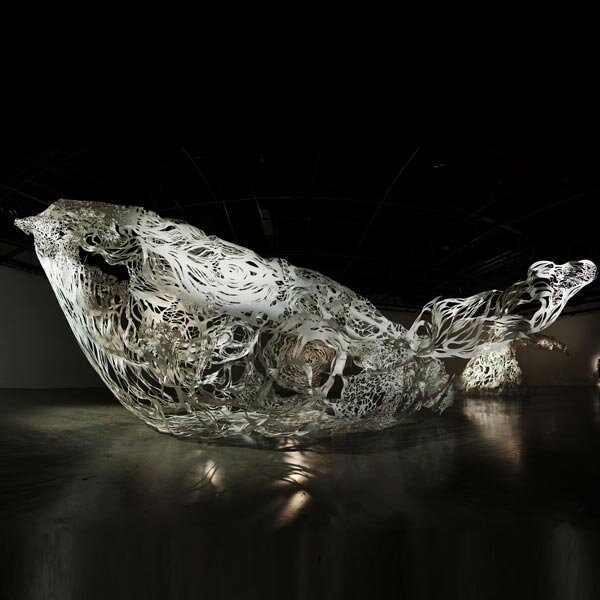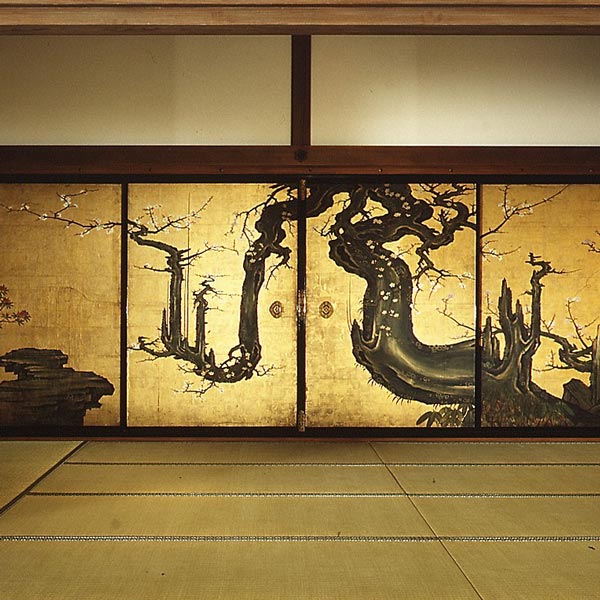Nihonga: 12 Masterpieces of Modern Japanese Art
by Lucy Dayman | ART
© Koji Mizutani, At Yoshino, 2003
Nihonga is style of art unique to Japan, unsurprisingly as the name literally means Japanese painting. Since the 19th century nihonga artists have been producing breathtaking works that are too little seen outside of the country.
This should soon change, as the Sato Sakura Museum in Tokyo has recently opened a gallery in New York. The Sato Sakura Gallery is the first western art gallery to focus on modern Japanese art in the nihonga style. If you’re not too sure exactly what nihonga is, then check out our Concise Guide, which covers all you need to know about this exquisite Japanese painting style. You can also take look at The Extraordinary Story of Japanese Art for a wider view!
One of the best ways to learn about nihonga is to dive in headfirst and explore the paintings from a simply visual standpoint. In order to explore the genre in a little more depth we’re are shining a light on some of the best contemporary Japanese artists of the genre. Read on to see 12 Masterpieces of Nihonga Japanese Art.
1. Chinami Nakajima
© Chinami Nakajima, Miharu Takizakura on a Spring Night, 1998
Born in 1945, the third son of famous nihonga painter Kiyoshi Nakajima, Chinami Nakajima managed to step out of his father’s shadow to become one of nihonga’s most celebrated talents thanks in part to this piece. It’s a textual depiction of a weeping cherry tree, its branches sagging under the weight of its blooming buds against the backdrop of an evening sky. Nakajima created this almost 3D imagery by layering the paint to give it a uniquely physical dimension.
2. Jun’ichi Hayashi
© Jun’ichi Hayashi, Takizakura, 2002
While Nakajima’s image portrays the famed sakura tree at night, we can imagine this masterpiece as a vision of the same tree painted just hours before. Created by Kyoto-born talent Jun’ichi Hayashi, this work encapsulates a visualization of the bitter coldness that lingers in the town of Miharu, Fukushima, where this painting is set. Hayashi is generally considered to be one of nihonga’s premier nature painters thanks to his ability to traverse the line between whimsical beauty and reality; this piece is an excellent example of his undeniable talents.
3. Koichi Nabatame
© Koichi Nabatame, Scene of the Rising Sun and Chrysanthemums, 1999
After sakura, the most iconic Japanese flower has to be the chrysanthemum. Bulbous and vividly colored, the flowers are a common motif in nihonga paintings, like this piece by Ibaraki-born artist Koichi Nabatame. Utilizing gold leaf painting, so commonly referenced in traditional Japanese art, this image of the warm orange sun glowing behind a bunch of chrysanthemums is both incredibly regal and yet the subject is so understated and everyday. It’s the encapsulation of the Japanese ability to find beauty in the most simple of objects.
4. Shun’ei Nishida
©Shun’ei Nishida, Taj Mahal, 2001
Definitely not a depiction of Japanese life, this piece by Mie’s Shun’ei Nishida is a recreation of the iconic Taj Mahal in India. Caught in the glossy white reflected light of the hovering moon, this picture uses motifs so commonly found in classic Japanese nihonga landscapes, but uproots them and places them in a whole new setting. The soft fauna framing the image and the hazy focus of the stunning structure, this combination of Indian landscape and Japanese artistic direction creates a fascinating piece of work.
5. Reiji Hiramatsu
© Reiji Hiramatsu, Path Scene of Takizakura, 1997
It’s amazing how talented artists all studying and practicing around the same time can come up with such different interpretations of the same subject. This piece by Tokyo-born Reiji Hiramatsu also depicts the fleeting beauty of a weeping cherry in the throes of spring. His angle, perception and use of bold color distinguishes Hiramatsu from other modern Japanese painters, this unique eye is probably why in 2013 the prestigious Giverny Museum of Impressionisms in France hosted a solo exhibition of Hiramatsu’s work.
6. Koichi Takeuchi
© Koichi Takeuchi, Caricature of Monkeys Enacting the Coming of Amida Buddha, 2003
More narrative-driven than the prior contemporaries in this list, is this vibrant and rhythmic piece is by Kyoto-born artist Koichi Takeuchi. Like little petals dancing in the wind, the monkey figures are moving with a lighthearted joyousness that’s almost leaps off the canvas. The soft blended brown background offsets rustic warmth, letting the colors in the foreground do all the work. It’s a fantastic example of the beauty of simplicity in nihonga art.
7. Yukihiko Kurihara
© Yukihiko Kurihara, Spring Evening Takizakura, 1993
More mystical, maybe even otherworldly than its sakura-rich counterparts, this piece by Shizuoka-born Yukihiko Kurihara feels like something ripped straight from the pages of an illustrated fantasy novel. Rather than making the blossoms the focal point of the image, Kurihara has decided to focus on the entire tree, forcing the blossoms to almost a second thought; an aura that comes and goes as fleetingly as the real spring flowers. What’s so impressive about this piece is it makes the viewer reassess their focus on flowers and rather notice the power of the tree that gives birth to them.
8. Koji Mizutani
© Koji Mizutani, At Yoshino, 2003
This is a multi-paneled piece crafted by the meticulous and talented Koji Mizutani, a painter born in Mie. During spring there is arguably no place more stunning than Yoshino, the rolling mountainous hills are covered in what seems like endless rows of cherry blossom trees.
© Koji Mizutani, At Yoshino, 2003
It’s almost like you’re standing atop a soft pink bubblegum cloud. In this piece Mizutani has encapsulated the transition the mountain goes through as its trees transform from green to pink during the passing seasons.
9. Yoshihiro Shimoda
© Yoshihiro Shimoda, Mont Saint-Michel, 2000
Balancing the fine line between fantasy and reality, this landscape painting is a unique take on the nihonga ideologies. Born in Toyama, the man behind the painting, Yoshihiro Shimoda, used this traditional Japanese art style to create something that is very un-Japanese, the image of Mont Saint-Michel of France. If you look closely you can see the image is broken up into four panels and uses the soft hazy painting techniques common in Shimoda’s work. Compared to his usual flora-focused efforts, this piece sees the talented painter really go out on a limb to try something new and worldly.
10. Susumu Maki
© Susumu Maki, Miharu Takizakura, 2000
Strictly adhering to the more traditional notions of Japanese art, this piece by Tokyo-born Susumu Maki focuses on bold color and a sense of suspended movement to recreate his version of the same stunning weeping cherry tree. This classic style is reminiscent of a Noh theater backdrop, the use of lines and shading so undeniably Japanese; Maki is a purist through and through. He has made waves throughout the world, most specifically in Paris when the Mitsukoshi Etoile Gallery hosted a solo exhibition of his work back in 1997.
11. Nobuyoshi Watanabe
© Nobuyoshi Watanabe, Five-colored Camellia, 2003
Camellias are a much loved flower in Japan; the appearance of their vividly colored, silky smooth blooms show that spring is in full force. Renowned nihonga artist Nobuyoshi Watanabe has taken great care to render each individual leaf and blossom in this beautifully detailed painting. The use of a solid color background further enhances the careful study of the plant itself.
12. Atsushi Uemura
©Atsushi Uemura, Winter Jobitaki (Phoenicurus Auroreus), 1990
Atsushi Uemura is a Kyoto born painter whose work is whimsical, dreamlike and undeniably enthralling. This piece depicts the somehow both fragile and resilient beauty of the Daurian redstart bird, known in Japan as Jobitaki. Flittering across the cold, crisp winter sky, the painting follows the journey of its small vibrating protagonist as it heads off on its continuing journey. Uemura’s love of birds and bird motifs continued throughout his career.
This season, check out the new nihonga exhibition Summer Gems at the Sato Sakura Gallery in New York, on display from July 11 to September 28, 2019.
Do you have a favorite Nihonga piece or artist? If so, we’d love to hear about it, leave a comment below!














LIFESTYLE | July 28, 2023